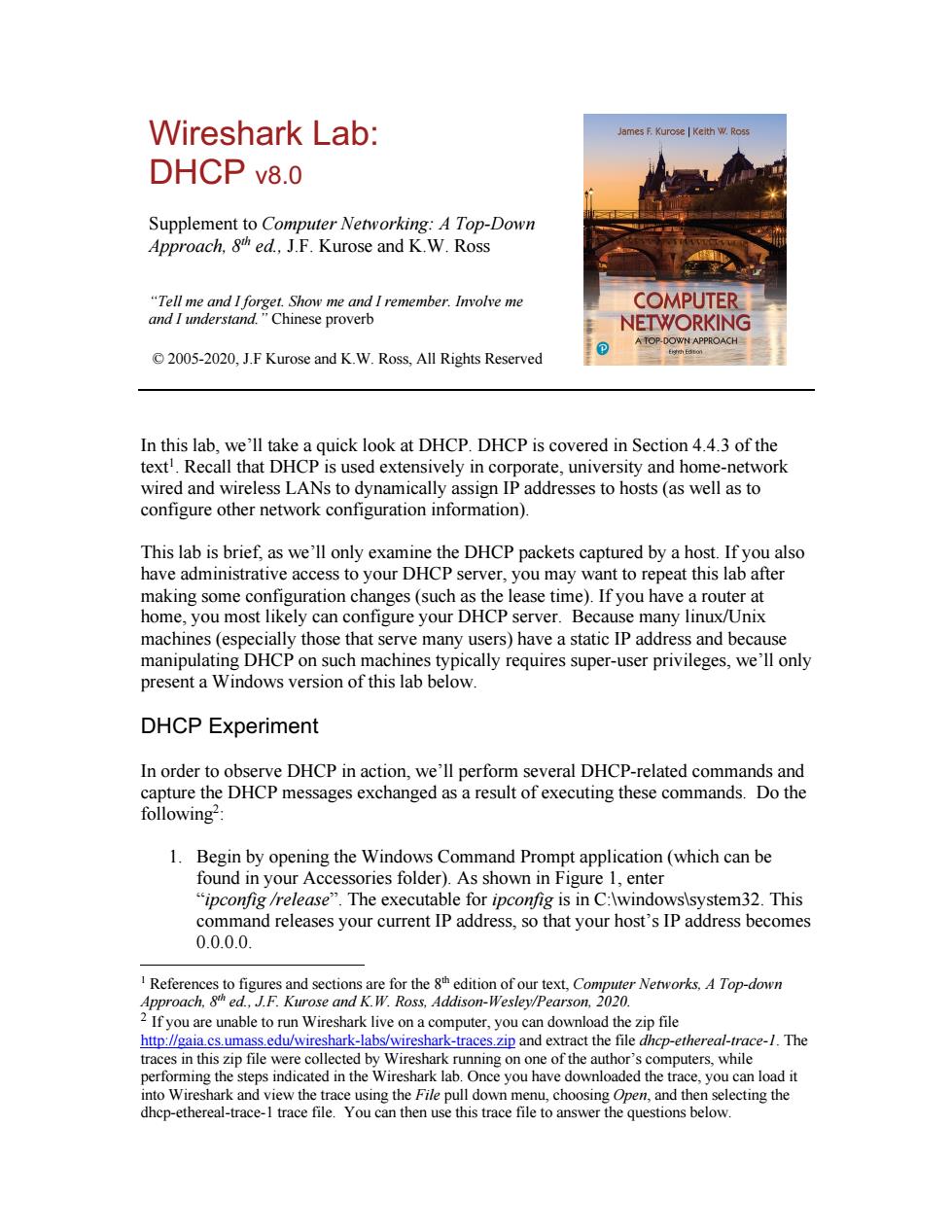
Wireshark Lab: DHCP v8.0 Supplement to Computer Networking:A Top-Down Approach,8h ed..J.F.Kurose and K.W.Ross COMPUTER NETWORKING 2005-2020.J.F Kurose and K.W.Ross.All Rights Reserved In this lab,we'll take a tex R ll that DH gtkshektDCPDHCpseovercdiasactom443ofthe is used extens university and wired and wireless LANs to This lab is brief,as we'll only examine the DHCP packets captured by a host.If you also have administrative access to your DHCP server,you may want to repeat this lab after making some configuration changes(such as the lease time).If you have a router at home,you most likely can configure your DHCP server.Because many linux/Unix machines(especially those that serve many users)have a static IP address and because manipulating DHCP on such machines typically requires super-user privileges,we'll only present a Windows version of this lab below. DHCP Experiment In order to obs nds and 1.Begin by opening the Windows Command Prompt application(which can be found in your Accessories folder).As shown in Figure 1,enter "ipconfig /release".The executable for ipconfig is in C:\windows\system32.This command releases your current IP address,so that your host's IP address becomes 0.0.0.0. er.you can d ce-I.The traces in this zip file were collected by Wireshark runningonone of the author's computers,while steps indicated in the Wireshar Once you have downloaded the ce,you can loa hep-thereace You n ile to wer the
Wireshark Lab: DHCP v8.0 Supplement to Computer Networking: A Top-Down Approach, 8th ed., J.F. Kurose and K.W. Ross “Tell me and I forget. Show me and I remember. Involve me and I understand.” Chinese proverb © 2005-2020, J.F Kurose and K.W. Ross, All Rights Reserved In this lab, we’ll take a quick look at DHCP. DHCP is covered in Section 4.4.3 of the text1 . Recall that DHCP is used extensively in corporate, university and home-network wired and wireless LANs to dynamically assign IP addresses to hosts (as well as to configure other network configuration information). This lab is brief, as we’ll only examine the DHCP packets captured by a host. If you also have administrative access to your DHCP server, you may want to repeat this lab after making some configuration changes (such as the lease time). If you have a router at home, you most likely can configure your DHCP server. Because many linux/Unix machines (especially those that serve many users) have a static IP address and because manipulating DHCP on such machines typically requires super-user privileges, we’ll only present a Windows version of this lab below. DHCP Experiment In order to observe DHCP in action, we’ll perform several DHCP-related commands and capture the DHCP messages exchanged as a result of executing these commands. Do the following2: 1. Begin by opening the Windows Command Prompt application (which can be found in your Accessories folder). As shown in Figure 1, enter “ipconfig /release”. The executable for ipconfig is in C:\windows\system32. This command releases your current IP address, so that your host’s IP address becomes 0.0.0.0. 1 References to figures and sections are for the 8th edition of our text, Computer Networks, A Top-down Approach, 8th ed., J.F. Kurose and K.W. Ross, Addison-Wesley/Pearson, 2020. 2 If you are unable to run Wireshark live on a computer, you can download the zip file http://gaia.cs.umass.edu/wireshark-labs/wireshark-traces.zip and extract the file dhcp-ethereal-trace-1. The traces in this zip file were collected by Wireshark running on one of the author’s computers, while performing the steps indicated in the Wireshark lab. Once you have downloaded the trace, you can load it into Wireshark and view the trace using the File pull down menu, choosing Open, and then selecting the dhcp-ethereal-trace-1 trace file. You can then use this trace file to answer the questions below
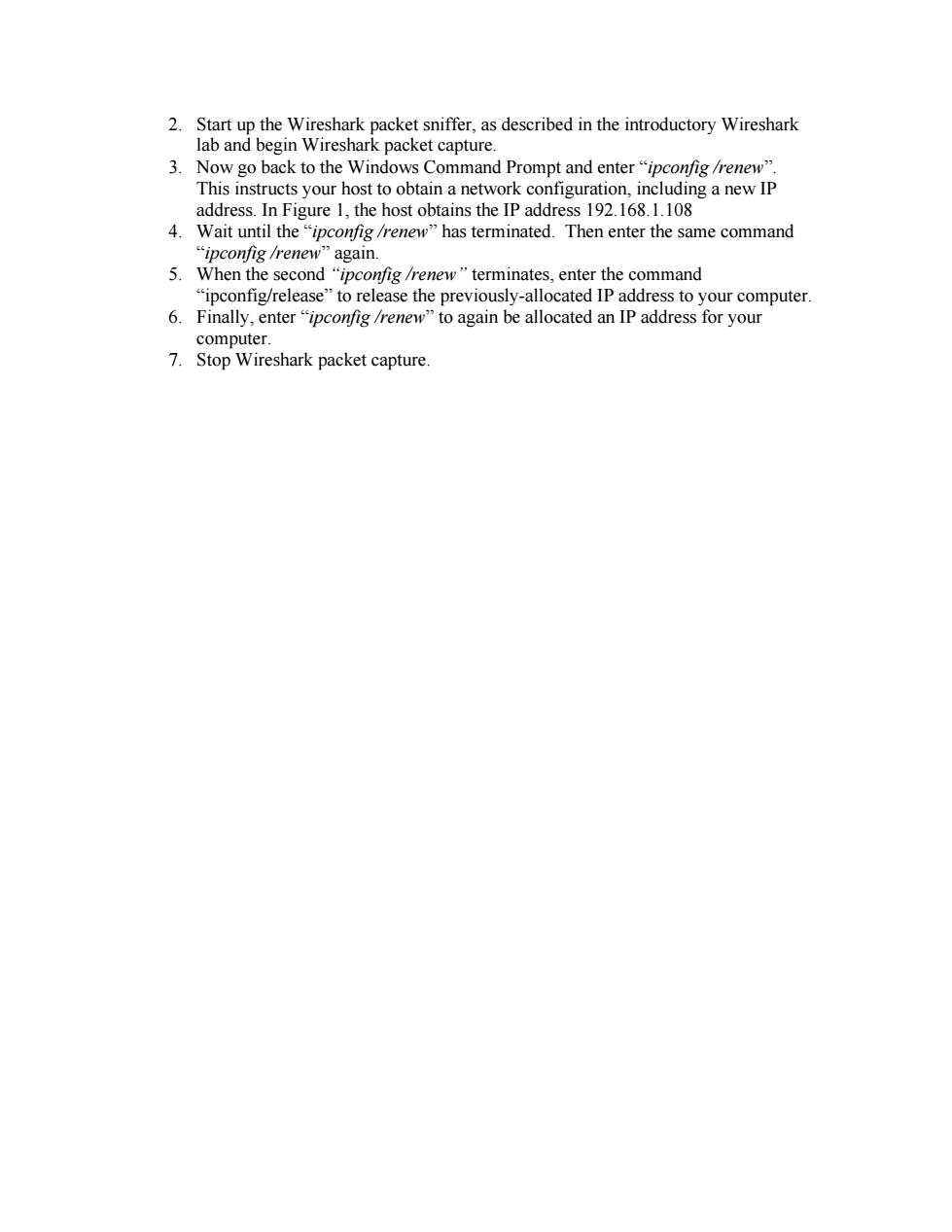
2.Start up the Wireshark packet sniffer,as described in the introductory Wireshark lab and begin Wireshark packet capture. 3.Now go back to the Windows Command Prompt and enter"ipconfig /renew" This instructs your host to obtain a network configuration.including a new IP address.In Figure 1.the host obtains the IP address 192.168.1.108 4.Wait until the“ipc onfig /renew"has terminated.Then enter the same command ew”a 5.When nd" onfig renew"terminates,enter the command fig/rele ase" P th ed IP addr 6.Finally,enter "pcong /renewto again be allocated an IP address mputer compu 7.Stop Wireshark packet capture
2. Start up the Wireshark packet sniffer, as described in the introductory Wireshark lab and begin Wireshark packet capture. 3. Now go back to the Windows Command Prompt and enter “ipconfig /renew”. This instructs your host to obtain a network configuration, including a new IP address. In Figure 1, the host obtains the IP address 192.168.1.108 4. Wait until the “ipconfig /renew” has terminated. Then enter the same command “ipconfig /renew” again. 5. When the second “ipconfig /renew” terminates, enter the command “ipconfig/release” to release the previously-allocated IP address to your computer. 6. Finally, enter “ipconfig /renew” to again be allocated an IP address for your computer. 7. Stop Wireshark packet capture

eCommand Prompt C:\WINDOUS\SYSTEM32>ipconfig/release Windows IP Configuration IP Address for adapter Local Area Connection has already been released. C:\WINDOWS\SYSTEM32>ipconfig/renew Windows IP Configuration ithernet adapter Local Area Connection: n5影:ent2 2::5 :、WIND0Ws、SYSTEM32>ipconfig/renew Windows IP Configuration thernet adapter Local Area Connection: nndrpeifie DNS Suffix eway 8 C:\WINDOWS\SYSTEM32>ipconfig/release thernet adapter Local Area Connection ddrionpecifie DNS Suffix :8888 C:\WINDOVS\SYSTEM32>ipconfig/renew dindows IP Configuration thernet adapter Local Area Connection erie is.com :\WINDOWS\SYSTEM32>_ Figure 1 Command Prompt window showing sequence of ipconfig commands that you should enter
Figure 1 Command Prompt window showing sequence of ipconfig commands that you should enter
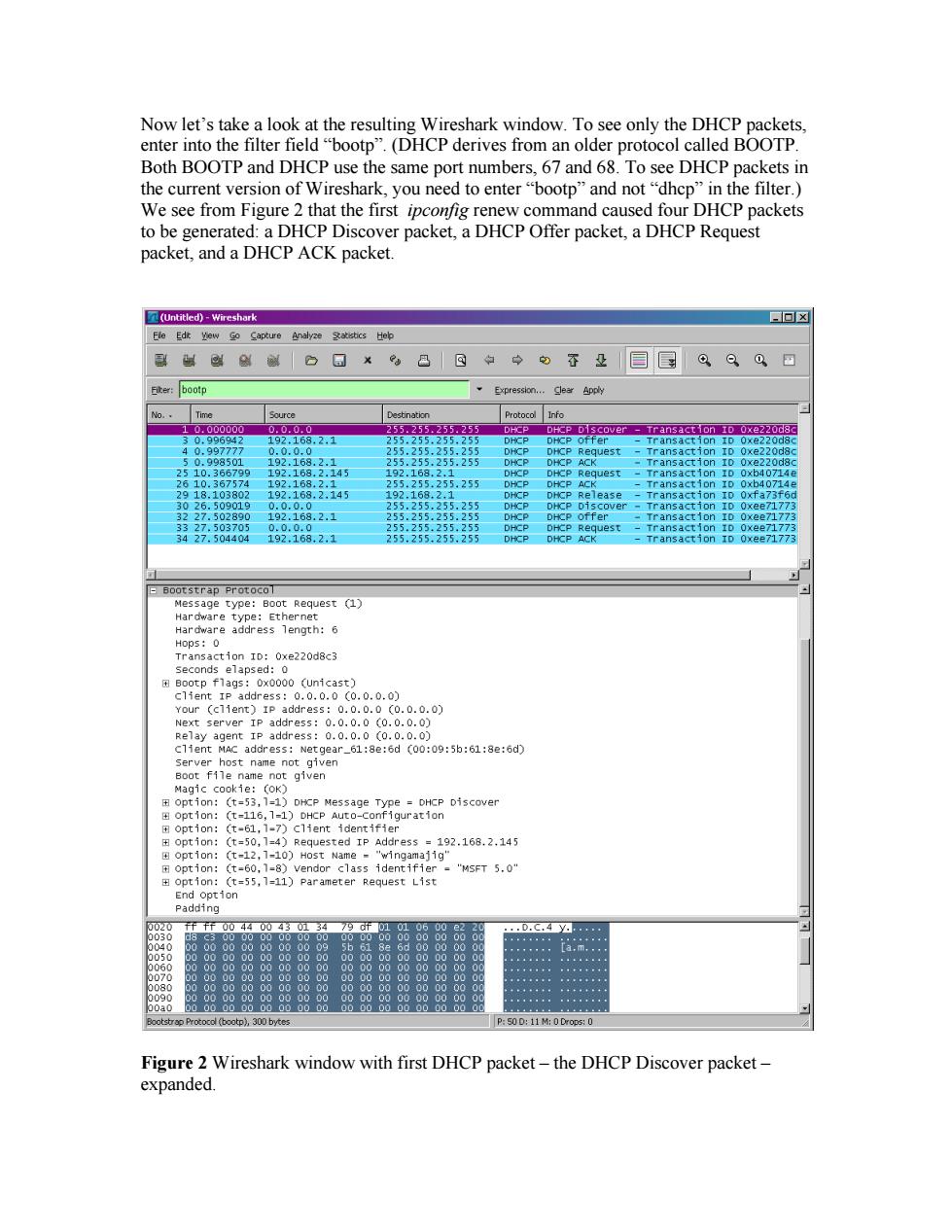
Now let's take a look at the resulting Wireshark window.To see only the DHCP packets. enter into the filter field"bootp".(DHCP derives from an older protocol called BOOTP. Both BOOTP and DHCP use the same port numbers,67 and 68.To see DHCP packets in the current version of Wireshark,you need to enter“bootp'”and not“dhcp”in the filter.) We see from Figure 2 that the first ipconfig renew command caused four DHCP packets to be generated:a DHCP Discover packet,a DHCP Offer packet,a DHCP Request packet,and a DHCP ACK packet. (Utitled)-wirshe 阿☒ 168.23 255 27.303703 00.00 tion ID:Oxe220dBc3 0-868rCo8:o9:5b:61:8e6d eoot flle name not give on: option:(t1.identifer ="M5FT5,0" 0 Dr 11 M:0 Drop Figure 2 Wireshark window with first DHCP packet-the DHCP Discover packet. expanded
Now let’s take a look at the resulting Wireshark window. To see only the DHCP packets, enter into the filter field “bootp”. (DHCP derives from an older protocol called BOOTP. Both BOOTP and DHCP use the same port numbers, 67 and 68. To see DHCP packets in the current version of Wireshark, you need to enter “bootp” and not “dhcp” in the filter.) We see from Figure 2 that the first ipconfig renew command caused four DHCP packets to be generated: a DHCP Discover packet, a DHCP Offer packet, a DHCP Request packet, and a DHCP ACK packet. Figure 2 Wireshark window with first DHCP packet – the DHCP Discover packet – expanded
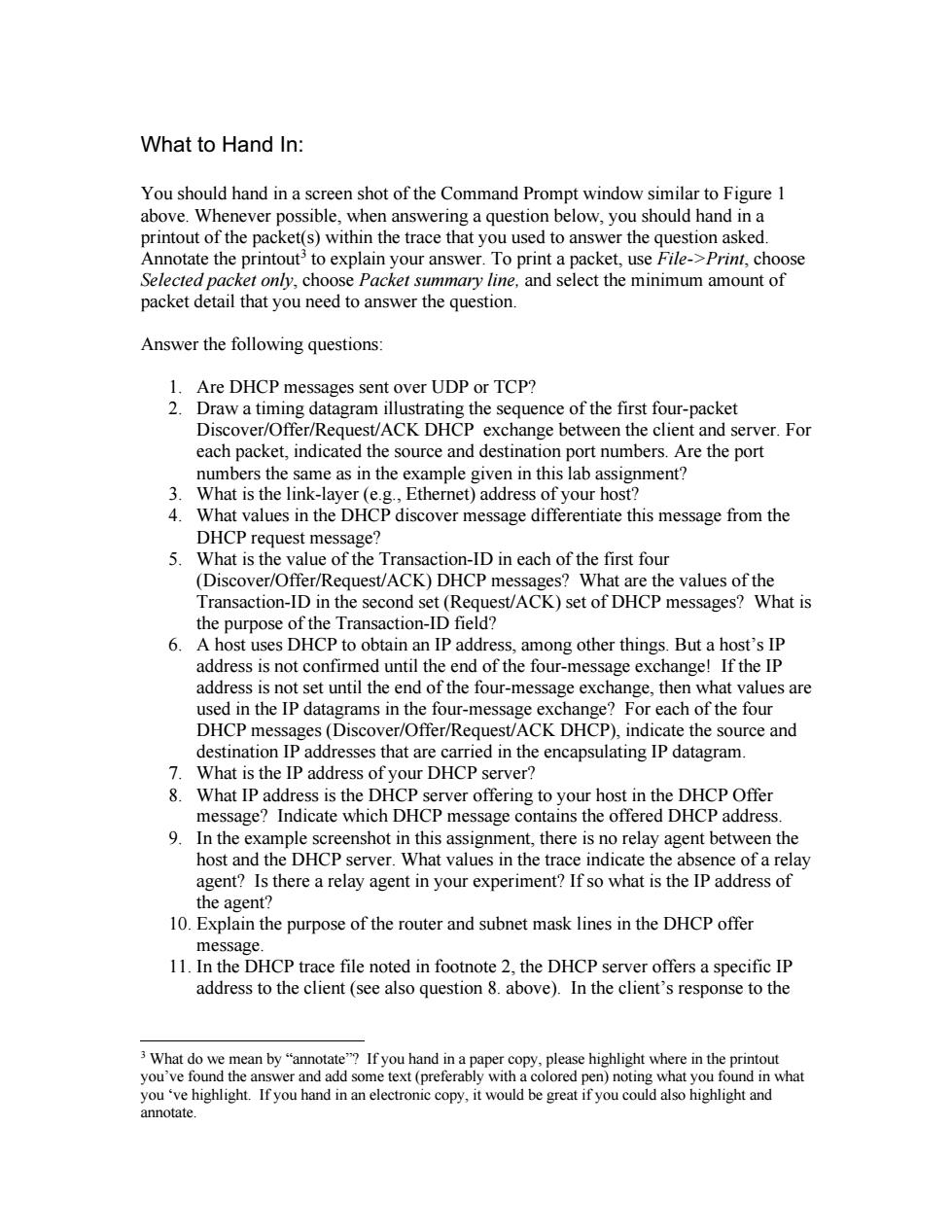
What to Hand In: You should hand of the Command Prompt window Figre1 above. pos sible should hand printout of the pack to answer the qu printou to expla ain your answer.To print a packet >Print,choose Selected pac t only,choose Packet summary line,and select the minimum amount of packet detail that you need to answer the question. Answer the following questions: 1.Are DHCP messages sent over UDP or TCP? 2.Draw a timing datagram illustrating the sequence of the first four-packet Discover/Offer/Request/ACK DHCP exchange between the client and server.For each packet,indicated the source and destination port numbers.Are the port numbers the same as in the example given in this lab assignment? 3.What is the link-layer (e.g.,Ethernet)address of your host? 4.What values in the DHCP discover message differentiate this message from the DHCP request message? What is the value of the trar saction-ID in each of the first four over/Of ction-ID in th estACK)DHCP。 es?What are the values of the uest/ACK)set of DHCP messages?What is the ofthe Tr ID 6. purpo st uses DHO D P addr among other thing But a host's IP ess is not confi until t he nd of the four-mes ge exch f th e IF address et until end t e four-message exch nge,th t values are grams in the four-message exch se each f the four DHCP messages(Discover/Offer/Request/ACK DHCP),indi ate the source and destination IP addresses that are carried in the encapsulating IP datagram. What is the IP address of your DHCP server? 8.What IP address is the DHCP server offering to your host in the DHCP Offer message?Indicate which DHCP message contains the offered DHCP address 9.In the example screenshot in this assignment,there is no relay agent between the host and the DHCP server.What values in the trace indicate the absence of a relay agent?Is there a relay agent in your experiment?If so what is the IP address of the agent? 10.Explain the purpose of the router and subnet mask lines in the DHCP offer message 11.In the DHCP trace file noted in footnote 2,the DHCP server offers a address to the clie nt (see also question 8.abo ve).In the client's se to the What do we mean by"annotate"?If you hand in a paper opy.please highlight where in the printout you've found colored highlight wer and add some text(preferably with If you hand in an electron hat you found in what e copy,wou ghlight and
What to Hand In: You should hand in a screen shot of the Command Prompt window similar to Figure 1 above. Whenever possible, when answering a question below, you should hand in a printout of the packet(s) within the trace that you used to answer the question asked. Annotate the printout3 to explain your answer. To print a packet, use File->Print, choose Selected packet only, choose Packet summary line, and select the minimum amount of packet detail that you need to answer the question. Answer the following questions: 1. Are DHCP messages sent over UDP or TCP? 2. Draw a timing datagram illustrating the sequence of the first four-packet Discover/Offer/Request/ACK DHCP exchange between the client and server. For each packet, indicated the source and destination port numbers. Are the port numbers the same as in the example given in this lab assignment? 3. What is the link-layer (e.g., Ethernet) address of your host? 4. What values in the DHCP discover message differentiate this message from the DHCP request message? 5. What is the value of the Transaction-ID in each of the first four (Discover/Offer/Request/ACK) DHCP messages? What are the values of the Transaction-ID in the second set (Request/ACK) set of DHCP messages? What is the purpose of the Transaction-ID field? 6. A host uses DHCP to obtain an IP address, among other things. But a host’s IP address is not confirmed until the end of the four-message exchange! If the IP address is not set until the end of the four-message exchange, then what values are used in the IP datagrams in the four-message exchange? For each of the four DHCP messages (Discover/Offer/Request/ACK DHCP), indicate the source and destination IP addresses that are carried in the encapsulating IP datagram. 7. What is the IP address of your DHCP server? 8. What IP address is the DHCP server offering to your host in the DHCP Offer message? Indicate which DHCP message contains the offered DHCP address. 9. In the example screenshot in this assignment, there is no relay agent between the host and the DHCP server. What values in the trace indicate the absence of a relay agent? Is there a relay agent in your experiment? If so what is the IP address of the agent? 10. Explain the purpose of the router and subnet mask lines in the DHCP offer message. 11. In the DHCP trace file noted in footnote 2, the DHCP server offers a specific IP address to the client (see also question 8. above). In the client’s response to the 3 What do we mean by “annotate”? If you hand in a paper copy, please highlight where in the printout you’ve found the answer and add some text (preferably with a colored pen) noting what you found in what you ‘ve highlight. If you hand in an electronic copy, it would be great if you could also highlight and annotate
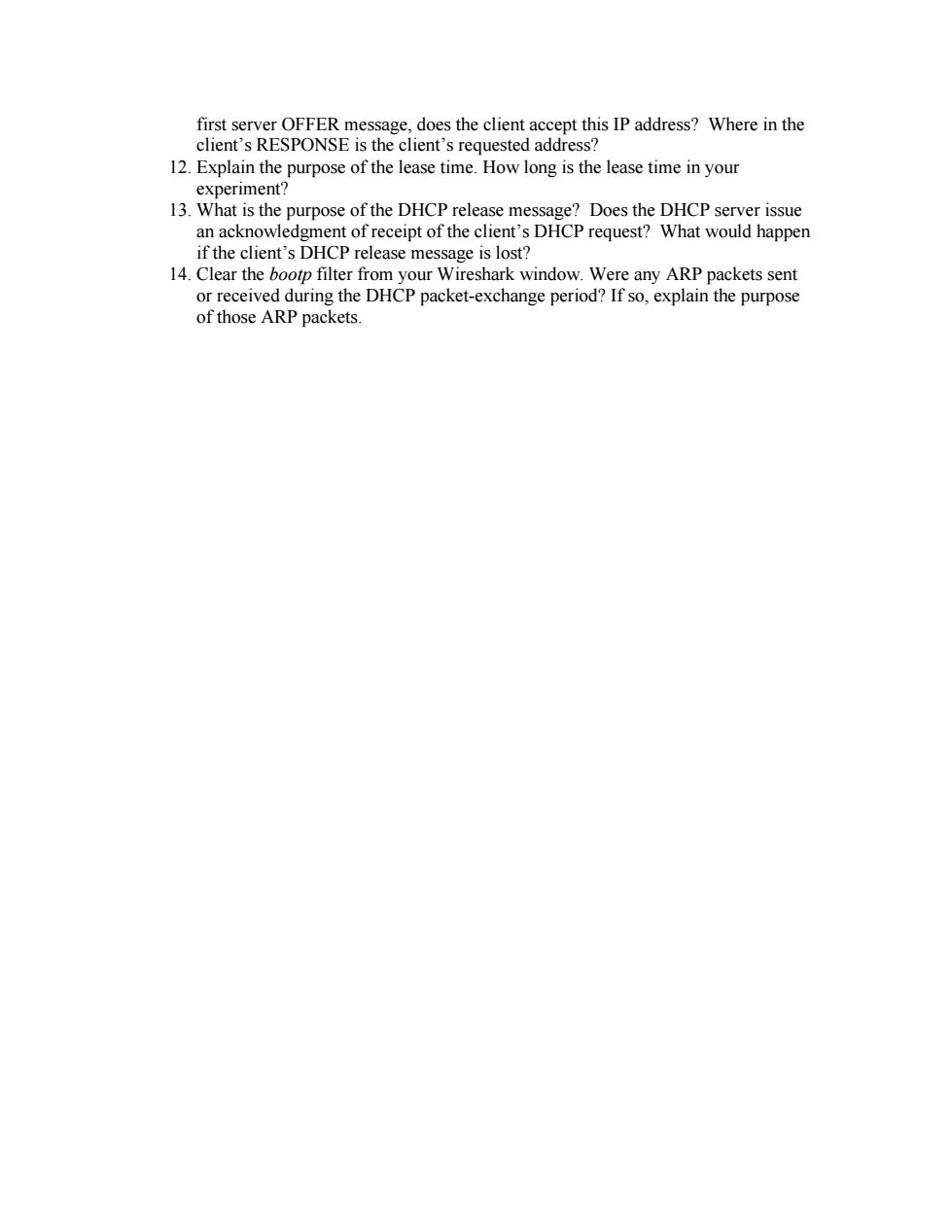
first server OFFER message,does the client accept this IP address?Where in the client's RESPONSE is the client's requested address? 12.Explain the purpose of the lease time.How long is the lease time in your experiment? 13.What is the purpose of the DHCP release message?Does the DHCP server issue an acknowledgment of receipt of the client's DHCP request?What would happen if the client's DHCP release ge is lost? 14 Clear the bootp filter from yo rWireshark window.Were any ARP packets sent the DHCP packet t-exchange period?If o,explair the purpos
first server OFFER message, does the client accept this IP address? Where in the client’s RESPONSE is the client’s requested address? 12. Explain the purpose of the lease time. How long is the lease time in your experiment? 13. What is the purpose of the DHCP release message? Does the DHCP server issue an acknowledgment of receipt of the client’s DHCP request? What would happen if the client’s DHCP release message is lost? 14. Clear the bootp filter from your Wireshark window. Were any ARP packets sent or received during the DHCP packet-exchange period? If so, explain the purpose of those ARP packets